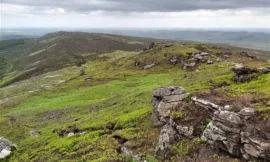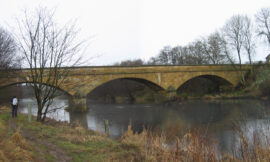Hadrian’s Wall stands as an iconic testament to the engineering prowess and strategic vision of the ancient Roman Empire. Stretching across the rugged landscapes of Northern England, this colossal fortification served as a formidable barrier against invading forces, symbolizing the might and determination of Rome during the 2nd century AD. The construction of Hadrian’s Wall, ordered by Emperor Hadrian in AD 122, marked a significant chapter in Roman military architecture and remains one of the most well-preserved and studied ancient structures in the world.
Stretching approximately 73 miles (117 kilometers) from the east to the west coasts of England, Hadrian’s Wall was a defensive fortification designed to separate Roman-controlled Britannia from the unconquered lands to the north, primarily inhabited by the Picts, a confederation of Celtic-speaking peoples. The wall was strategically positioned to guard key Roman settlements and maintain control over the northern frontier.
The wall itself was an engineering marvel, constructed with meticulous attention to detail. Made primarily of stone and turf, it soared to a height of 15 feet (4.5 meters) in some sections and spanned a width of 8 feet (2.4 meters). The Roman soldiers who built it, along with local laborers, faced challenging terrain, including hills, valleys, and rivers. Forts, milecastles, and turrets were strategically placed along the length of the wall, creating a formidable defensive system. The Wall also featured a military road, the Stanegate, running parallel to it, facilitating the movement of Roman troops.
One of the notable aspects of Hadrian’s Wall was its symbolic and strategic significance. Beyond its military function, the Wall served as a clear marker of the empire’s reach and power. It conveyed a message of Roman dominance and control, acting as a deterrent to potential invaders. Additionally, the Wall demonstrated Hadrian’s commitment to consolidating and securing the existing boundaries of the empire, emphasizing defense over expansion.
The forts along Hadrian’s Wall housed Roman soldiers and provided them with the necessary infrastructure to maintain a strong military presence in the region. Garrisontowns, such as Vindolanda and Housesteads, emerged around these forts, becoming vibrant communities with markets, temples, and civilian dwellings. These settlements played a crucial role in connecting the Roman way of life with the local population, fostering cultural exchange and trade.
Hadrian’s Wall was not a permanent solution, and subsequent Roman emperors would go on to build additional fortifications farther north. However, the legacy of Hadrian’s Wall endures as a UNESCO World Heritage Site and a symbol of Roman engineering and military strategy. Its remnants, including the well-preserved sections and archaeological discoveries, offer a glimpse into the life and challenges faced by the Romans in this northern frontier.
Today, Hadrian’s Wall continues to attract visitors from around the world, drawing them into a journey through time as they explore the remnants of this ancient structure. It stands as a testament to the enduring impact of Roman civilization and the strategic foresight of Emperor Hadrian, whose vision shaped not only the landscape of Northern England but also the pages of history.



